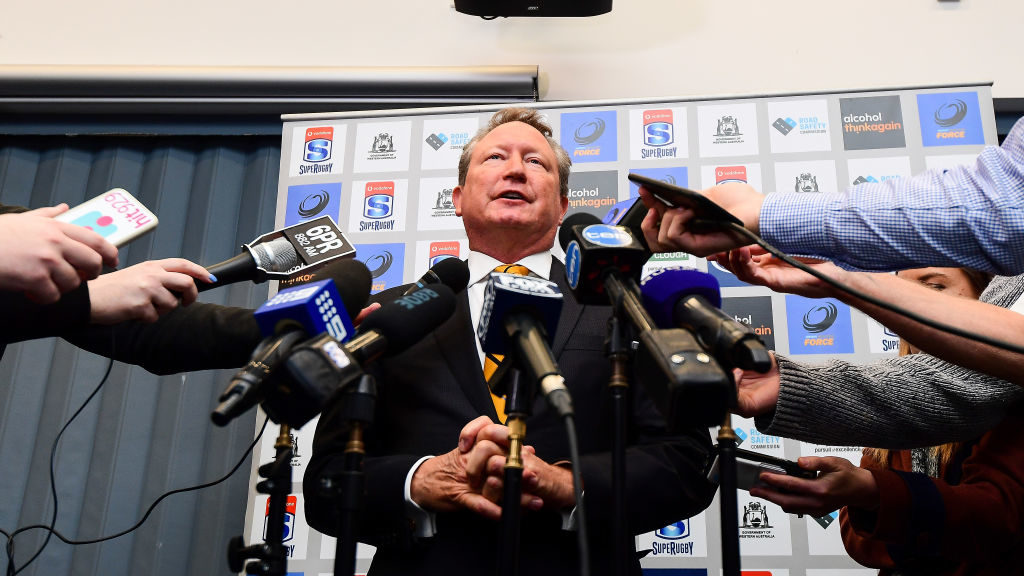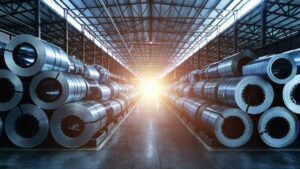Lessons from the Masters: Here’s how Twiggy Forrest spreads his investments

Pic: Daniel Carson/Getty Images via Getty Images
- Andrew Forrest is worth anywhere up to $30 billion, largely off his major shareholding in his iron ore miner Fortescue Metals Group
- He has around $500 million of disclosed equity stakes in other ASX-listed companies, including nickel miners, agriculture and food stocks
- Alongside his philanthropic pursuits Forrest has built a large portfolio of private business interests in sport, clothing, property, cattle stations and energy investments
Andrew Forrest is the billionaire more than any other whose rapid ascent to the top of Australian society tells the story of the 2000s mining boom.
Chastened from the near collapse of Anaconda Nickel, Forrest reemerged in 2003 as the chairman and CEO at Fortescue Metals Group (ASX:FMG), a penny stock founded on the relatively simple premise that China wanted more iron ore than Australian majors could export.
The former stockbroker and onetime alpaca farmer who grew up on Minderoo Station in WA’s north was proven right.
Despite the inferior grade of the ore mined from the vast swathes of WA’s Pilbara pegged by Fortescue, China’s economy and steel industry was in a rapid phase of growth.
Forrest, who has maintained a more than 36% slice and high degree of control over Fortescue for a number of years even after he initially stepped down as CEO in 2011, profited.
He spun his chunky dividend cheques into a range of investments, philanthropic gestures and political influence.
He now has a whiff of the ‘teal independents’ about him, a reflection of the wave of inner-city anger over climate change that turned long-time Liberal voters into haters in Saturday’s election.
Fresh off completing a PhD in Marine Ecology with the help of his own ocean research vessel — a little out of reach of his ramen-rich colleagues — Forrest reemerged as the main man at FMG by denouncing himself as a carbon emitter and announcing plans to make the miner a global leader in clean energy.
The radical upheaval brought by the change in direction, formation of Fortescue Future Industries and resignation of FMG CEO Elizabeth Gaines have brought Forrest back into the fold as its executive chairman, a move announced last week.
Assessments of his wealth vary.
It last clocked in at a net worth of $27.25 billion on last year’s AFR rich list, $30.5 billion according to the Bloomberg Billionaires Index, and $27 billion according to Forbes.
One thing is for certain, Forrest’s wealth has skyrocketed in the two years since the pandemic began as iron ore prices hit record highs.
With China’s economy in slowdown mode and uncertainty around FMG’s dramatic move into ‘green hydrogen’, are there other Twiggy stock picks delivering more upside?
Where is Twiggy invested on the ASX?
Twiggy’s investments are dominated by his stake in Fortescue, now the third largest mining company on the ASX worth upwards of $63 billion at today’s price.
The fourth biggest iron ore exporter in the world with record guidance of 185-188Mt of shipments in FY2022, it is one of the greatest stories of value creation in Australian business history.
Under the direction of CEO Nev Power from 2011-2018, the debt-saddled company rode out the storm of the mining downturn by rivalling and in some cases beating global supermajors BHP (ASX:BHP) and Rio Tinto (ASX:RIO) for unit costs, a position that helped Twiggy’s FMG thrive when benchmark prices hit records upwards of US$230/t last year.
It is not just Twiggy and his executives who did well out of the FMG deal. The reclusive Kie Chie Wong, the Australian-based son of a Sarawak timber milling dynasty who made a $1m investment in Fortescue in 2003 (then worth over a quarter of the company), has also been reported as a billionaire from his minority stake.
On Monday we assessed the value of Forrest’s 36.5% stake, largely held through his family company Tattarang, at $23.2 billion, making up well over 95% of his listed portfolio wealth.
As with many billionaire investors, a vast amount of his wealth is held outside public markets, including the dividend cheques regularly delivered by FMG (tallying a dizzying $4 billion in FY2021), property, private mining and energy companies, agriculture, cattle stations, and the Harvey Beef and RM Williams businesses among other ventures.
But Forrest’s entry into a number of listed entities has sparked interest and excitement over the years.
Disclosed Forrest ASX shareholdings
Source: IRESS/ASX Company Announcements
| CODE | COMPANY | SHARES | % | VALUE |
|---|---|---|---|---|
| POS | Poseidon Nick Ltd | 85777000 | 2.7995 | $ 6,347,498.00 |
| IPT | Impact Minerals | 81025216 | 3.699 | $ 972,302.59 |
| MCR | Mincor Resources NL | 50368948 | 10.3993 | $ 122,396,543.64 |
| PAN | Panoramic Resources | 48381638 | 2.359 | $ 12,579,225.88 |
| WSA | Western Areas Ltd | 29406763 | 9.1427 | $ 112,921,969.92 |
| FMG | Fortescue Metals Grp | 1122131637 | 36.4719 | $ 23,216,903,569.50 |
| IXC | Invex Ther | 8846154 | 11.7707 | $ 4,865,384.70 |
| SWP | Swoop Holdings Ltd | 33413809 | 16.2497 | $ 21,050,699.67 |
| EMD | Emyria Limited | 20000000 | 7.2727 | $ 6,000,000.00 |
| ASB | Austal Limited | 18248316 | 5.0598 | $ 36,496,632.00 |
| BGA | Bega Cheese Ltd | 30328343 | 10 | $ 144,969,479.54 |
| AAC | Australian Agricultural | 31998695 | 5.3086 | $ 65,597,324.75 |
| RIC | Ridley Corporation | 20864186 | 6.5304 | $ 35,777,580.60 |
| TOTAL | $ 23,786,878,210.79 |
The bulk of Forrest’s ASX investments sans FMG are now held in Tattarang, the rebranded investment arm of Minderoo split off and renamed to distinguish itself from Forrest’s philanthropic interests in the Minderoo Foundation.
Within that diverse set of investments is Wyloo Metals, Forrest’s private mining company.
Given his role establishing the Murrin Murrin nickel mine with Anaconda, Australia’s first nickel laterite operation, it is unsurprising Wyloo and Forrest have focused more attention on nickel than any other commodity.
Forrest’s reemergence in the nickel game came in 2007.
In a nod to his stockbroking past and embrace of Australiana he became the chairman and main shareholder of Poseidon Nickel (ASX:POS), aiming to revive the Windarra mine that was at the centre of the original Poseidon bubble in the 1960s — a seminal moment in Australian capital markets history for both good and bad reasons.
While Poseidon is finally getting close to resuming production not at Windarra but at the old Black Swan mine near Kalgoorlie, Forrest recently shaved his stake down to under 5%, leaving US private equity group Black Mountain Metals as the largest investor.
But Wyloo has emerged as one of the clans in Australian nickel’s Game of Thrones, amassing the largest stake in near-term Kambalda nickel producer Mincor Resources (ASX:MCR) and being kingmaker in IGO’s (ASX:IGO) successful takeover bid for Western Areas (ASX:WSA).
Now that nickel is shifting from its traditional use in stainless steel to becoming a critical component of electric vehicles, expect the clean, green Forrest to take an even stronger interest.
That was demonstrated in his high stakes battle for control of Canada’s Noront Resources last year against BHP, now privately controlled by Wyloo, when BHP was unable to match Wyloo and Forrest’s final offer of C$1.10 a share, a massive 47% above BHP’s C75c bid.
Wyloo will spend C$25 million delivering feasibility studies to investigate the development of Noront’s assets in Canada’s remote Ring of Fire nickel district.
Putting down the shovel
Forrest’s curiosity has been a hallmark of his investment strategy, and he has been happy to back ideas outside of mining.
Many of his private investments have a touch of sentiment — saving the Western Force rugby team from collapse and his ownership of the iconic Indiana teahouse in Cottesloe for instance.
Others draw on his pastoral background, with his investments in his cattle stations, Harvest Road and Harvey Beef complemented by large stakes in listed companies like Bega (ASX:BGA) and more recently the Australian Agricultural Company (ASX:AAC).
Forrest last year also threatened to play blocker to Brazil food processor JBS’ eventually successful $425 million takeover of salmon farmer Huon.
Then other investments are more unusual. Take for instance Tattarang’s significant stakes in synthetic cannabinoid producer Emyria (ASX:EMD) and telco Swoop (ASX:SWP).
Neither have been winners so far. Emyria has traded sideways since the Tattarang investment but was in a trading halt yesterday pending the release of a trial result. Swoop meanwhile doubled on debut but has slid 52.8% since to just 59c.
In the energy space Forrest is traversing with Fortescue Future Industries, and has shifted his onshore gas explorer Squadron Energy into the green energy field.
Through Squadron, Forrest is a major investor in the multi-billion dollar Sun Cable project alongside Mike Cannon-Brookes. Squadron was the joint leader of a $210 million Series B raise in March for the project, which is aiming to take solar energy generated in the NT and transport it via a high voltage direct current cable to Darwin and Singapore.
Here are a few interesting stocks from the Forrest stable (aside from Fortescue obv).
MINCOR RESOURCES (ASX:MCR)
Forrest was first revealed as a substantial investor in Mincor in late 2019, amid a series of fundraising rounds the company launched to back the restart of its Kambalda nickel operations.
According to ASX filings Forrest began amassing his stake in August 2019, when MCR was worth around 55c.
While he added to his position subsequently, the iron ore magnate would be well in the money, with a surge in nickel prices, the growth of the EV market and MCR’s successful restart of mining propelled the $1.17 billion company to a $2.43 share price as of this week.
RBC reckons it could run further, with ore now going through BHP’s Kambalda concentrator and cash flows expected this quarter. The investment bank has a $2.75 price target on the WA nickel miner.
Mincor Resources (ASX:MCR) share price today:
BEGA CHEESE (ASX:BGA)
Speaking of Twiggy’s taste for Australiana, Tattarang forked out more than $100 million in December last year for a stake in Bega Cheese, the producer of Aussie staple Vegemite.
He has been building the stake in the food and dairy stock ever since, pulling up to 10% in April.
That came shortly after a pretty ordinary trading update from the company, which said Covid-19 would deliver a $40 million hit with the lockdowns in Shanghai and war in Ukraine adding to its concerns.
‘Normalised’ full year EBITDA is expected to tally $175-190 million. Shares in the ~$1.5 billion firm are down a not so happy 15% year to date.
Bega Cheese (ASX:BGA) share price today:
RIDLEY CORPORATION (ASX:RIC)
Low key one of the better non-Fortescue stock picks in the Tattarang stable, stockfeed supplier Ridley has been on the up and up since hitting a low point at the start of the pandemic.
Forrest paid ~$12 million between August 2020 and February 2021 to amass a substantial stake in the $543m agristock, which is sitting close to record highs at $1.70, up 49.12% over the past 12 months.
The supplier of Cobber dog food and Barastoc reported a barking mad 124.4% increase in NPAT to $22.6 million in the first half of the year.
Ridley Corporation (ASX:RIC) share price today:
Related Topics
UNLOCK INSIGHTS
Discover the untold stories of emerging ASX stocks.
Daily news and expert analysis, it's free to subscribe.
By proceeding, you confirm you understand that we handle personal information in accordance with our Privacy Policy.








